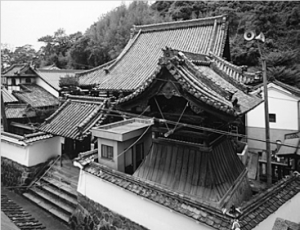Saikoji (temple)
 In October 1730, the Head Temple of the Jodo-Shinshu Hongwanji-ha bestowed the wooden standing statute of Amida Nyorai as the principal subject of worship on the village along with the templefs name gSaikojih. In 1748, eighteen years after the bestowal, the villagers built the temple, whose main building was consisted of eight pillars and four eaves in all directions, on the site of some 962 m2. The number of households in Iwasaki Village, which was later renamed into Kashihara, was reportedly only 38, compared to 550 as of December 2004.
In October 1730, the Head Temple of the Jodo-Shinshu Hongwanji-ha bestowed the wooden standing statute of Amida Nyorai as the principal subject of worship on the village along with the templefs name gSaikojih. In 1748, eighteen years after the bestowal, the villagers built the temple, whose main building was consisted of eight pillars and four eaves in all directions, on the site of some 962 m2. The number of households in Iwasaki Village, which was later renamed into Kashihara, was reportedly only 38, compared to 550 as of December 2004.The Japanese drum, displayed in the western corner of the main building, was originally hung in the drum room, located in the first floor of the old living quarters of the priests. The letters on the leather of the drum says, gMaintenance done in the fourth year of the Keio era [the year 1968]h; since it means that the drum was recovered with the new leather in the said year, you cannot know when the drum itself was made unless you look inside the drum. Since the drum looks very old, however, it may be that it was made around the time when the Saikoji temple was build.
The letters inscribed on the flagstone in front of the main building says, gMembers of the Nunsf Meetingh and gOrganizers KIMURA Mino, IKEDA Tomih. The Nunsf Meeting is assumed to be a kind of Buddhist womenfs association of today.
Since there were no centers or meeting facilities for the liberation from discrimination, the villagers reportedly gathered in the precincts in response to sound of the Saikojifs alarm bell when something happened, such as the issue of the consolidation to the main village (Kashihara Village) or the struggle for the integration of schools.
The letters on the headstone of SAIKO Mankichifs grave were written by NISHIGUCHI Toshio, who was born in Kobayashi, Gose City, and served as the Chairperson of the National Research Council for Dowa Education. The Founding Declaration of the Suiheisha, written by SAIKO Mankichi himself, is also inscribed.
The site of KOMAI Kisakufs house
SAKAMOTO Seiichiro, SAIKO Mankichi and KOMAI Kisaku - the gthree young men of Kashiharah who were the core members in the creation of the Zenkoku Suiheisha - grew up together like brothers. The oldest was SAKAMOTO, with SAIKO three years younger and KOMAI five years younger. The house where KOMAI was born was located in front of the Saikojifs gate, and the house where SAKAMOTO was born was to the immediate east of the site of the premises of the village headman SAKAMOTOfs head family, which was located to the east of the temple. The three men grew up together in such a small area.In the autumn of 1921, the doorplate of gthe Office for the Creation of the Suiheishah was hung out beside the front door of KOMAIfs house. After the authority became more vigilant to their activities, however, the doorplate was reportedly moved to a shanty on the riverside of Soga River, flowing on the outskirts of the village, while actual preparations continued to be undertaken at KOMAIfs house.
The site of SAKAMOTO Kiyotoshifs house
(Note: Different Chinese characters came to be used to represent gsakah
in the modern period)
The premises of SAKAMOTOfs house perhaps had an area of some 1,000m2, with storehouses on the four corner of the premises. When you went through the 3.6m-wide gatehouse, you could see the room detached from the main house as well as the courtyard on the left; the main house could be seen from the gatehouse on the other side of the front garden. There was a back garden as well. The entrance, which was reconstructed after the World War II, seemed to have been the one with the plate-type steps as was the case in the main building of the Saikoji. An enormous amount of written materials on Iwasaki Village were discovered from the housefs storehouses.
This was the house of the grandfather of SAKAMOTO Seiichiro, SAKAMOTO Seigoro who was the village headman of Iwasaki Village when the Emancipation Edict was issued to abolish the discriminatory class system. SAKAMOTO Kiyotoshi, who was 28 years older cousin of Seiichiro and subsequently succeeded the family estate of the head family, also lived in the house. Kiyotoshi demonstrated his ability, for example, in the struggle for the integration of schools and became a leader of the villagers. He also visited Buraku districts within Nara Prefecture to advocate for the abolition Buraku schools and their integration into main schools, saying, gIf you educate children of Buraku districts and children outside Buraku districts in segregation, you cannot eliminate discrimination forever. Mix them in educationh.
SAKAMOTO Kiyotoshi became the Vice President of the Yamato Doshi Kai (Japan Association of Kindred Spirits), whose founding congress was held in the Myokoji Temple, Nishinosaka, Nara City, on 20 August 1912. He was later elected to the Minamikatsuragi County Assembly.
[Back]
[Home]